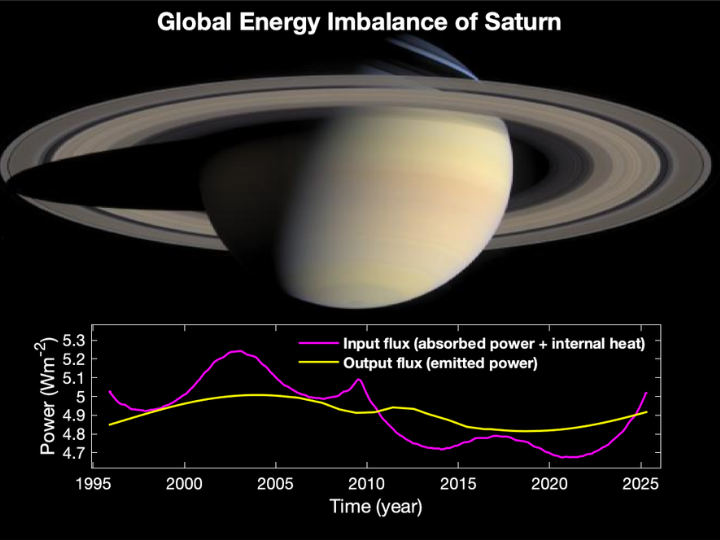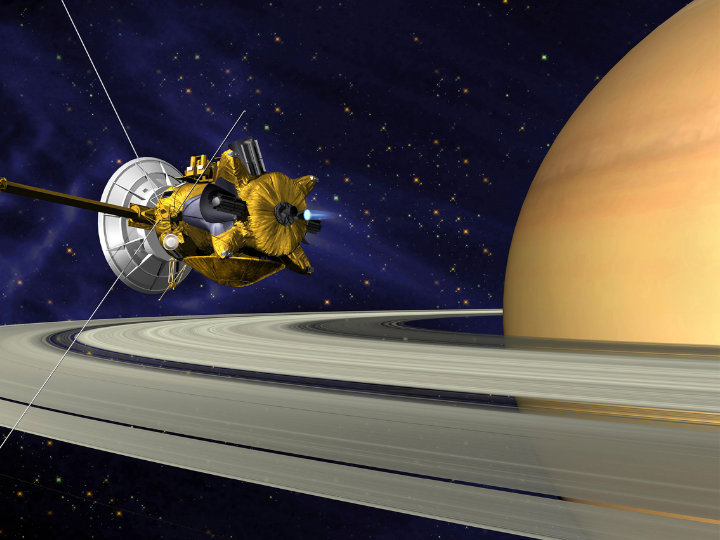A groundbreaking discovery by researchers at the University of Houston has revealed a massive energy imbalance on Saturn, shedding new light on planetary science and evolution and challenging existing climate models for the solar system’s gas giants. The findings appear in the scientific publication Nature Communications.

“This is the first time that a global energy imbalance on a seasonal scale has been observed on a gas giant,” said Liming Li, physics professor in the UH College of Natural Sciences and Mathematics. “Not only does this give us new insight into the formation and evolution of planets, but it also changes the way we should think about planetary and atmospheric science.”
Using data from the Cassini probe mission, Xinyue Wang, a third-year doctoral student in NSM’s Department of Earth and Atmospheric Sciences, found a significant and previously unknown seasonal energy imbalance on Saturn.
“Every planet gets energy from the sun in the form of solar radiation and loses energy by emitting thermal radiation,” Wang said. “But Saturn, like the other gas giants, has another energy input in the form of deep internal heat affecting its thermal structure and climate.”

The imbalance is due to Saturn’s large orbital eccentricity which varies by nearly 20% from aphelion (the point in orbit farthest from the sun) to perihelion (the point in orbit closest to the sun) resulting in huge seasonal variations in absorbed solar energy. Unlike Saturn, Earth does not experience a significant seasonal energy imbalance due to its very small orbital eccentricity.
“Earth does have a measurable energy budget, but it’s primarily determined by absorbed solar energy and emitted thermal energy,” said atmospheric sciences professor Xun Jiang. “Earth’s internal heat is negligible and its seasons last only a few months compared to seasons that are several years long on Saturn.”
The data also suggests that Saturn’s unbalanced energy budget plays a key role in the development of giant storms which are a dominant weather phenomenon in the planet’s atmospheric system. This data may also provide some insight into weather on Earth.
“To our knowledge, the role of energy budget in the development of moist, convective storms on Earth has not been fully examined, so we plan to investigate that as well to see if there’s a connection,” Wang said.
The Cassini mission, an ambitious, collaborative effort between NASA, the European Space Agency and the Italian Space Agency, launched in 1997 and explored Saturn and its rings and moons for nearly 20 years. Professor Li was chosen as a participating scientist to monitor three onboard instruments that observed Saturn’s radiant energy budget.
Wang, along with fellow graduate students Larry Guan (physics) and Thishan D. Karandana G and Ronald Albright (earth and atmospheric sciences), conducted the study, advised by professors Li and Jiang.
“In current models and theories of the atmosphere, climate and evolution of the gas giants, the global energy budget is assumed to be balanced,” Wang said. “But we believe our discovery of this seasonal energy imbalance necessitates a reevaluation of those models and theories.”
Li’s team now has its sights set on the other gas giants, including Uranus, where a flagship probe mission is planned in the next decade.
“Our data suggests these planets will have significant energy imbalances as well, especially Uranus, which we predict will have the strongest imbalance due to its orbital eccentricity and very high obliquity,” Wang said. “What we’re investigating now will identify limitations in current observations and formulate testable hypotheses which will benefit that future flagship mission.”
In addition to the researchers at UH, the study’s authors include scientists from NASA, the University of Wisconsin, the University of Maryland, the University of Central Florida and the University of California, Santa Cruz, as well as scientists from France and Spain.
Additional study authors:
Robert West, Senior Research Scientist, NASA Jet Propulsion Laboratory
Mark Hofstadter, Senior Planetary Scientist, NASA Jet Propulsion Laboratory
Daniel Wenkert, Senior Academic Researcher, NASA Jet Propulsion Laboratory
Matthew Kenyon, Senior Engineer, NASA Jet Propulsion Laboratory
Conor Nixon, Associate Laboratory Chief, NASA Goddard Space Flight Center
Amy Simon, Senior Planetary Scientist, NASA Goddard Space Flight Center
Patrick Fry, Researcher, Space Science and Engineering Center, University of Wisconsin
Anthony Mallama, Astronomer, University of Maryland
Joshua Colwell, Physics Department Chair, University of Central Florida
Xi Zhang, Planetary Sciences Professor, University of California, Santa Cruz
Tristan Guillot, Senior Planetary Scientist, Université Côte d’Azur (France)
Santiago Perez-Hoyos, Physics Professor, University of the Basque Country (Spain)
Agustin Sanchez-Lavega, Physics Professor, University of the Basque Country (Spain)